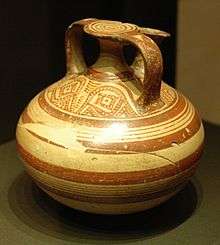Stirrup jar

A stirrup jar is a pottery vessel probably originating in the ancient Mediterranean region. Such vessels were sometimes decorated with painted designs or ornamentation. Throughout history including modern times have created versions of this vessel. Early examples of the stirrup jar have been recovered from Rhodes dating to c. 1200 BC.[1] A number of inscribed Kydonian stirrup jars have been recovered from several archaeological sites on Crete.[2]
Stirrup jars were originally intended for use as containers for oil and wine. The early stirrup jars were sparsely decorated and featured a three handled arrangement, disc hole, spout horns, and the shape of a false neck and spout. Traditionally stirrup jars were divided into two versions: a small, fine ware version suggesting a specialized use and a large, coarse ware version.[3]
The features found suggest that the stirrup jar could have been economically valuable. The arrangement of the stirrup jar suggests a stopper is used to secure the contents and the contents are what make the stirrup jar a valuable household item. The disc holes and third handle may have been used to secure a tag to the vessel suggesting a commercial importance and resale value. The locations where stirrup jars have been found in reflect the fact that the popularity of this vessel type spread quickly throughout the Aegean and the use of the stirrup jar to identify a specific commodity became important.[3]
See also
- Amphora
- Bridge spouted vessel
- Stirrup spout vessel, a similarly named South American vessel
References
- ↑ "'Octopus Style' stirrup jar". The British Museum. Retrieved 15 October 2013.
- ↑ "Cydonia". The Modern Antiquarian. Retrieved 15 October 2013.
- 1 2 Haskell, Halford W. (April 1985). "The Origin of the Aegean Stirrup Jar and Its Earliest Evolution and Distribution". American Journal of Archeology. 2. 89: 221–229. JSTOR 504326.